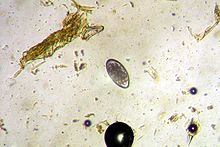Haemonchus contortus

Haemonchus contortus, also known as red stomach worm, wire worm or Barber's pole worm, is very common parasite and one the most pathogenic nematode of ruminants. Adult worms are attached to abomasal mucosa and feed on the blood.
Females may lay over 5,000 eggs a day, which are secreted from the animal via the faeces. After hatching from their eggs, H. contortus larvae molt several times, resulting in an L3 form that is infectious for the animals. They can take up these larvae when eating grass leaves. The L4 larvae, formed after another molt, suck blood in the abomasum of the animal, potentially giving rise to anaemia and oedema, which eventually can lead to death.[1]
The infection, called Haemonchosis, causes large economic losses for farmers around the world, especially for those living in the warmer climates. Antihelminthics are used to combat these, and other, worm infections for a long time, but resistance of the parasites against these chemicals is growing.
- ^ "Haemonchus, Ostertagia, and Trichostrongylus spp". The Merck Veterinary Manual. 2006. Retrieved 2007-07-01.
